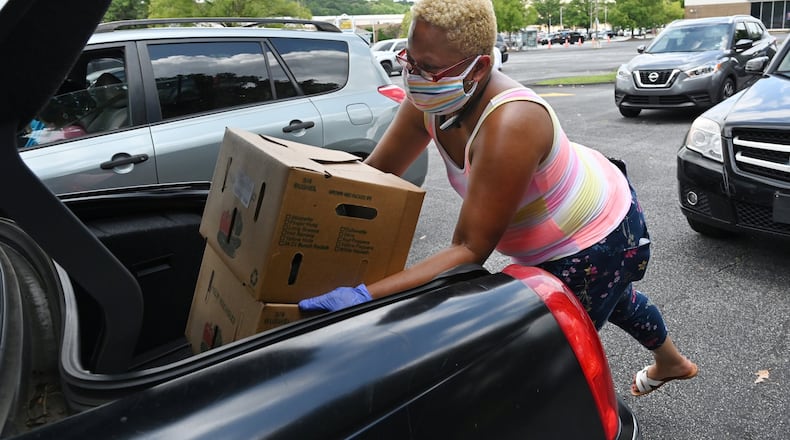Black households in Georgia and metro Atlanta are more likely to experience food scarcity during the coronavirus pandemic compared to their white counterparts, recent estimates released by the federal government suggest.
Troubling disparities surrounding food insecurity along racial lines existed before COVID-19 hit, research shows. But preliminary survey data from the U.S. Census Bureau indicates those gaps have only widened in Georgia as the pandemic forced millions out of work, disproportionately affecting Black and Hispanic families’ ability to put food on the table.
At a recent food drive at The Gallery at South DeKalb, county commissioner Larry Johnson stood at the front of a long line of cars that snaked through the mall’s parking lot.
“Look at this line,” he said. “These folks are coming because they’re hungry. They need help, they need food.”
Credit: Hyosub Shin
Credit: Hyosub Shin
More than 250,000 Black households in Georgia — about 11% — either sometimes or often did not have enough to eat before the pandemic began, according to an AJC analysis of Census estimates from surveys conducted in mid-June. During the pandemic, however, that number grew to about 15.5% of Black households, and 22% of Hispanic households.
Among white families, 5% experienced food scarcity in mid-March, and 7% in June, according to the Census estimates.
“When you start off at a disadvantage, it gets magnified when you’re dealing with a pandemic,” Johnson said. “COVID has made everything a little more crystal clear around disparities.”
While food insecurity has gone up across the board during the pandemic, experts say, the well-documented racial wage gap between what minorities and white workers earn and other systemic inequities have exacerbated food access issues.
“It’s the baked-in racism in the system, down to how much money people are able to make compared to their counterparts, which then means how much income you have to purchase good food,” said Jamila Norman, who operates an urban farm in Atlanta and manages the South West Atlanta Growers Cooperative.
Credit: Hyosub Shin
Credit: Hyosub Shin
Norman advocates for increased food security by promoting urban farms that provide fresh food to communities of color. She said when she first moved to the Westside, she was shocked to see that the community’s food options were “a bunch of fast food” and one Kroger. The commercial food landscape has not changed much since then, she said, but the coop now has 15 Black growers — the highest concentration of urban gardens anywhere in the city.
Jerry Shannon, a University of Georgia professor who has studied “food deserts” and food access in urban areas, said Black residents are over-represented in service positions and other industries where jobs were either cut during the pandemic or deemed “essential,” which could put the workers at an increased health risk.
“We know that there’s ongoing racial disparities in food insecurity that are being amplified,” Shannon said. “The disparities were there long before COVID came up, and I think that’s a bigger conversation about how the economy works.”
Across the state, the food insecurity rate could rise to nearly 18% during the coronavirus pandemic, up from 13% in 2018, according to Feeding America, a national nonprofit with a network of food banks. The recent Census estimates suggest that across racial groups, families with children are more likely to suffer from food scarcity.
Shannon pushed for increased funding for the state’s Supplemental Nutrition Assistance Program, also known as food stamps, which he said could help more people afford groceries and reduce some of the racial disparities. Norman has argued for more governmental and private investment in Atlanta’s predominantly Black neighborhoods provide more fresh, affordable options for residents.
The data comes from the Census Bureau’s nationwide weekly “Household Pulse Survey”; the agency said the experimental, real-time estimates are meant to provide accurate data about the ongoing impact of the pandemic.
About the Author
The Latest
Featured




